Pretty much everyone reading this will know someone who has died or been seriously injured on the roads. The stats are horrific:
1,700 deaths per year
28,000 life changing injuries (like a permanent disability)
Just consider the ripple out from those to family, friends, the broader community. Every single year. A trend has been almost unchanged for over a decade.
So many crashes could be avoided if people simply stuck to the law. Yet too often on the road there is lawlessness, with people:
- Driving whilst scrolling/typing on their phone
- Clearly exceeding the speed limit
- Driving in a careless or dangerous manner, for instance crossing unbroken white lines
This usually the point where someone says: “But I saw a cyclist go through a red light!!!”
Yeah, well, 2% of pedestrian casualties involve a cycle. Maybe sort out the other 98% involving motor vehicles first?
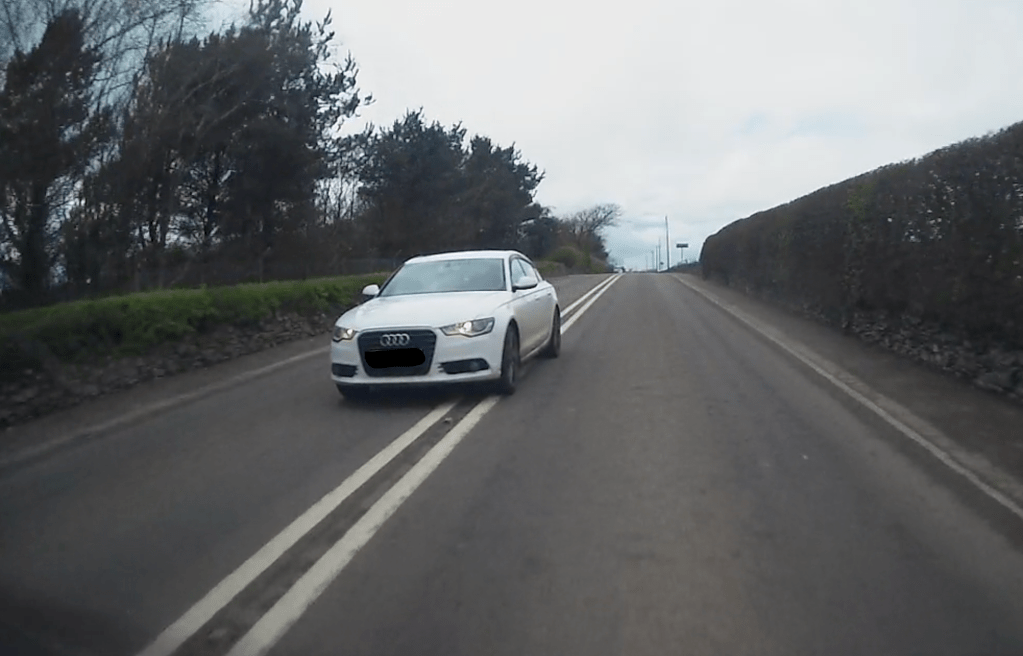
In that vein, the police are asking for people to provide evidence of road incidents to try and change drivers ways before they are involved in a really serious incident. And this is coming from the top of the service- Detective Superintendent Andy Cox headed up road safety for English forces and wrote a blog commending 3rd party reporting.
I will use the phrases dashcam/helmet cam pretty interchangeably here to mean any footage submitted by the public from any device. So that could include a mobile phone recording by a wheeler showing dangerous pavement parking for instance.
What can’t I submit?
Firstly, a big caveat. The police can only deal with very specific instances. A few things they cannot help with:
- Where the ONLY offence is related to parking eg. Parking on a double yellow line
- Pavement parking unless there is a clear safety issue caused (see below)
- Speeding however obvious it may seem
- Anything where the evidence just wouldn’t stand up to an objective person
What can I submit?
- Driving whilst touching a mobile phone. To be clear, the law is you should not be using any interactive features on your phone whilst in control of a motor vehicle.
- Parking on zig-zags at crossings and schools. This is a safety issue (not a parking issue) and is police enforced
- Crossing an unbroken white centre line
- Driving through a red light
- Close passing a person on a cycle
- Illegal number plates
- Undertaking, especially where it is to gain advantage on another road user
- Failure to comply with a road sign eg. no entry
- Obstruction of a mandatory cycle lane (this has an unbroken white line eg. Upper Bristol Road)
- Intensionally entering an ‘advance stop box’ at traffic lights (marked with a bicycle symbol)
- Driving without due care and attention (careless driving)
- Dangerous driving
It is worth reading the definition of what careless driving in full:
The offence of driving without due care and attention (careless driving) is committed when your driving falls below the minimum standard expected of a competent and careful driver, and includes driving without reasonable consideration for other road users
And dangerous driving:
The offence of dangerous driving is when driving falls far below the minimum standard expected of a competent and careful driver, and includes behaviour that could potentially endanger yourself or other drivers.
As you can see, there is a degree of subjectivity in these. As a member of the public, all you can do it submit. It is down to the reviewing officer to decide. Careless/dangerous driving tend to exhibit several offences happening in quick succession or concurrently.
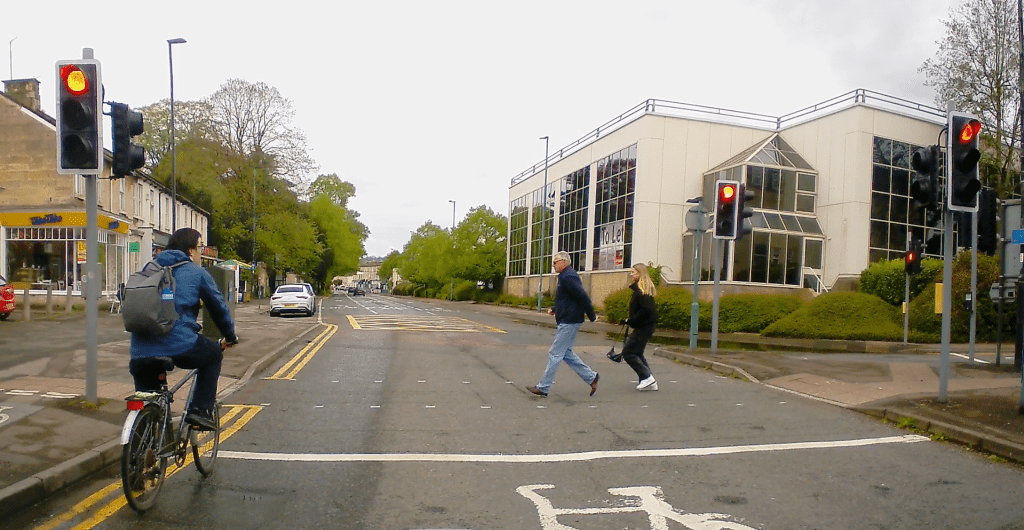
Don’t waste your time
One of the biggest challenges is the sheer scale of law breaking. This is the whole reason the police alone cannot hope to enforce even the basics as things stand. And the last thing they need is lots of ‘so-so’ footage. It wastes your time (each submission takes at good 10-15 minutes) and it waste theirs. So whatever you do, only submit when things are:
Really, really clear. Cut and dry. Incontrovertible.
You may feel someone is tailgating you aggressively, but unless they are beeping their horn and flashing their lights, it probably won’t stack up based just on the footage. You may be able to clearly tell that someone is on their phone and it is in their lap. But if you can’t see it in their hand, again it just won’t stack up.

I cannot stress this enough. The police have limited resources and they need to stay laser focused on footage that gets results.
Here are some examples of things that do make the grade:
Helmet cam footage of mobile phone use- Yes, it is the classic one made famous by Cycling Mikey. It is easy to get clear footage and the 6 points / £200 are likely to give people at least some pause for thought about their approach to driving. Distraction by electronic devices is one of the biggest contributors to road crashes.
Mobile phone footage of parking on zig-zags- A short video showing the vehicle parked on zig-zags is hard to contradict
Close passing a cyclist- 1.5m up to 30mph and 2m above. Both helmet cams and dash cams can provide good footage
Close passing a horse rider and horse- ditto
Driving the wrong way round a traffic island- The white arrow on a blue background? Not obeying that is failure to comply with a road sign.
Dangerous obstruction of the pavement- It is possible for the police to take action BUT it need to be pretty obscene like all wheels are on the pavement and it is clear a buggy or mobility scooter could not get past. The police need to see a dangerous obstruction of the pavement, and dangerous seems to mean forcing people to walk/wheel in the road.
Pissed off with pavement parking because is cracks paving slabs? Us too. But that is not going to reach the threshold.
Red Light- Yes, but it has to be utterly blatant.
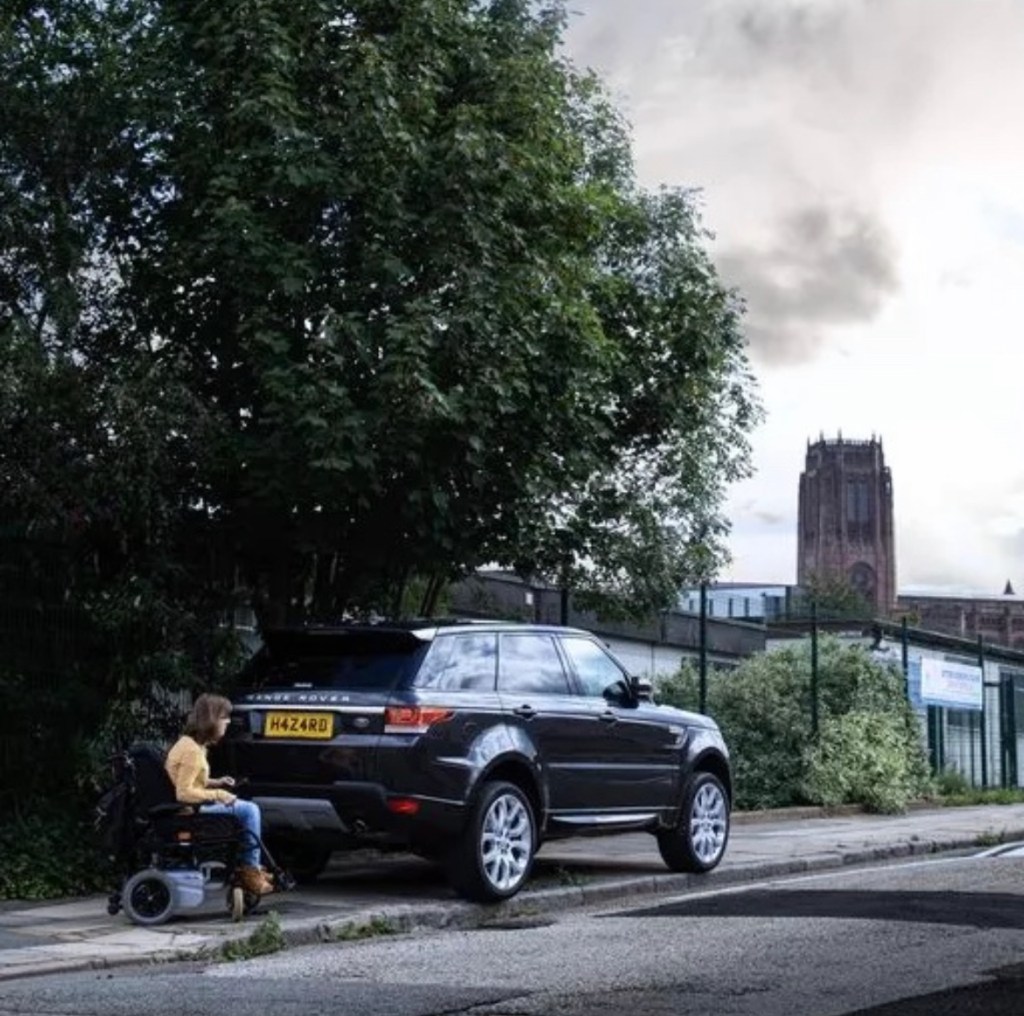
Footage capture tips
- You do not need 2 minutes. This duration is often suggested but it is not hard and fast. It is to show context especially if there is any suggestion one party provoked the other in any way. A 20 second video of someone driving whilst clearly scrolling on Instagram can be plenty.
- Be sure the number plate is clear. Read it out loud if possible.
- There is no need to engage with people. You are simply capturing footage. It is down to the police to decide what it shows.
- Never seek to entrap people. Attend to your own road behaviour first and foremost. Walk/bike/scoot/wheel/ride/drive as you hope everyone else would. Indeed, by choosing to record your journey, you are holding yourself to a high bar. If you are in an incident, you can bet your bottom dollar the police will want your footage!
- Never push the point. There is no shortage of law breaking. The next person will be along very soon.
- A rear view can really help, but of course this requires a second camera.
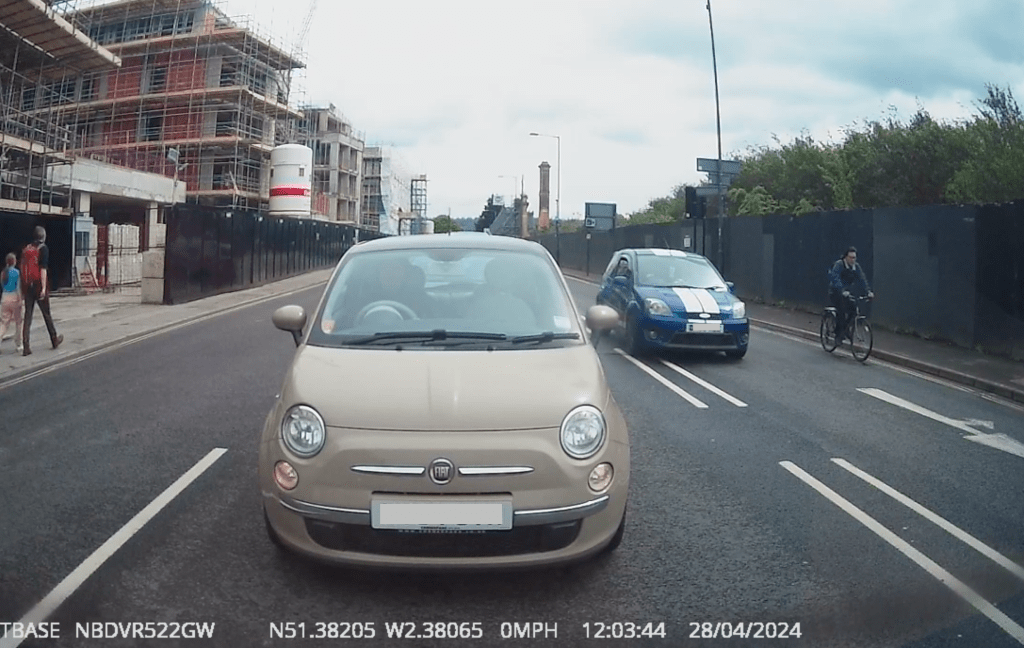
Submission tips
- This is the link to the Avon and Somerset dashcam portal.
- For other police areas, go to the Dashcam Safety Portal for an interactive map
- Do it immediately if possible and within 7 days. There are strict time limits on many offences
- Check you got the registration right. You can check a plate online and if the vehicle make and colour are right, then you probably are too
- Be clear on the exact location. What 3 Words is ideal. Avon and Somerset ask you to place a pin on a map.
- Be clear on the exact date and time, to the point of writing it to the second eg. 16:43:34. This helps the reviewing officer quickly get to the pertinent place in the recording.
- Stick to the facts. You are not the judge or jury, just a reporter.
- Keep all the footage including 2 minutes either side of the incident (if you have it) even if you don’t bother uploading all of it initially.
- Never post anything to social media etc. until after a case is closed.
The outcomes
The police will usually acknowledge your submission and provide a reference. Sometimes that is the last you will hear. In Avon & Somerset you will get a follow up email. In a nutshell, they will say either it has been accepted or not. If not, the phase used is NFA- No Further Action. And that is that.
If it has been accepted (and around 70% are), the police will choose one of the following:
- A warning letter
- An educational course
- Conditional offer of points and/or fine
- Notice of Intent to Prosecute (NIP) by other means, eg. At a magistrates court
They may say which action they chose, they may not. Depends on the force. See the example responses.
It is possible for things to end up in court if people plead ‘not guilty’. In these cases you would need to provide a written statement and may be called to give evidence in court.
In practise this is extremely rare- most people on viewing the footage realise they don’t have a leg to stand on. But some just want their day. It is a big risk as magistrates can impose far higher penalties- and often do.
If you really want to get into the how and why, Thames Valley Police (TVP) have a useful summary outlining decision making in an interactive flow chart.
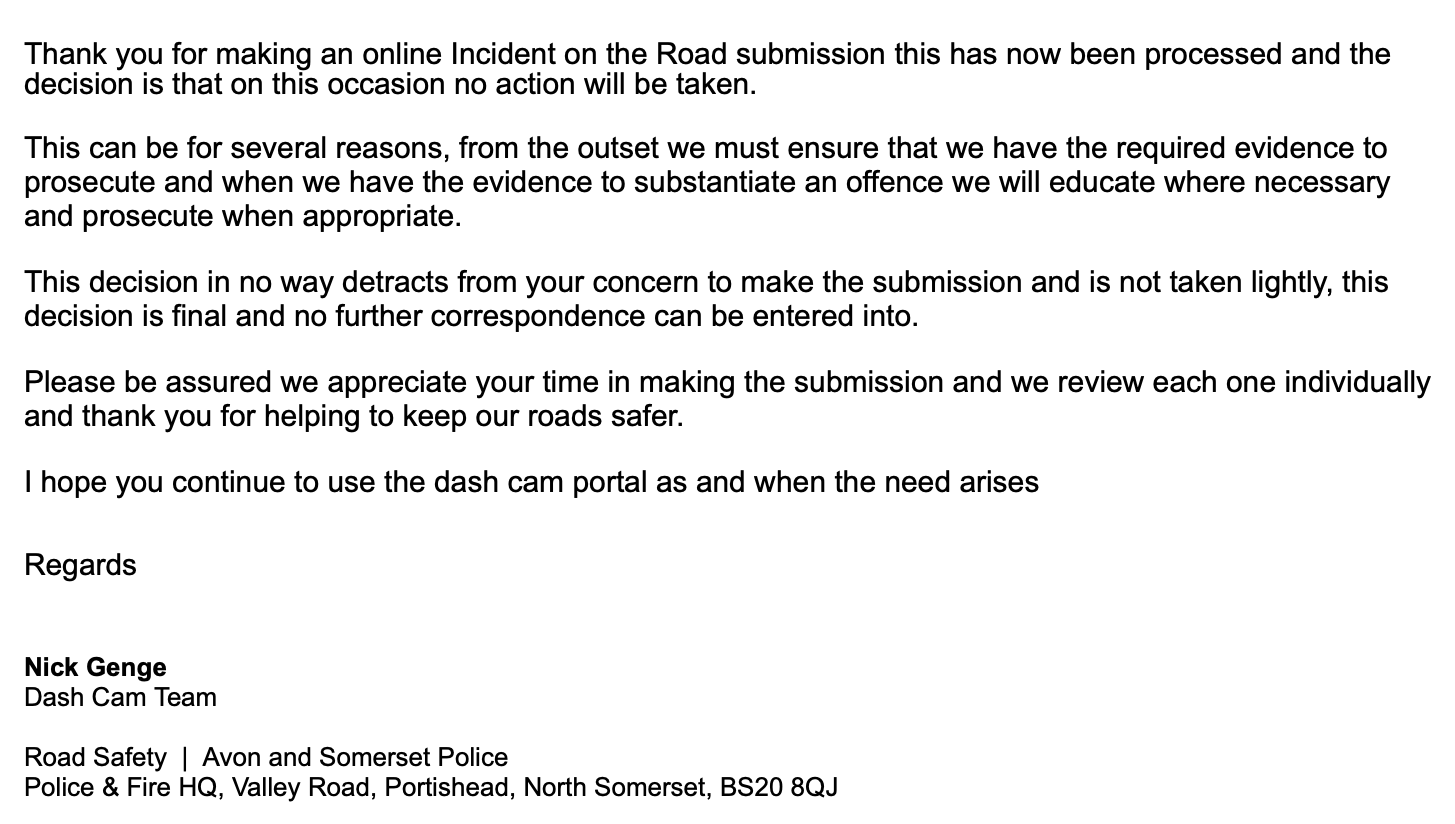
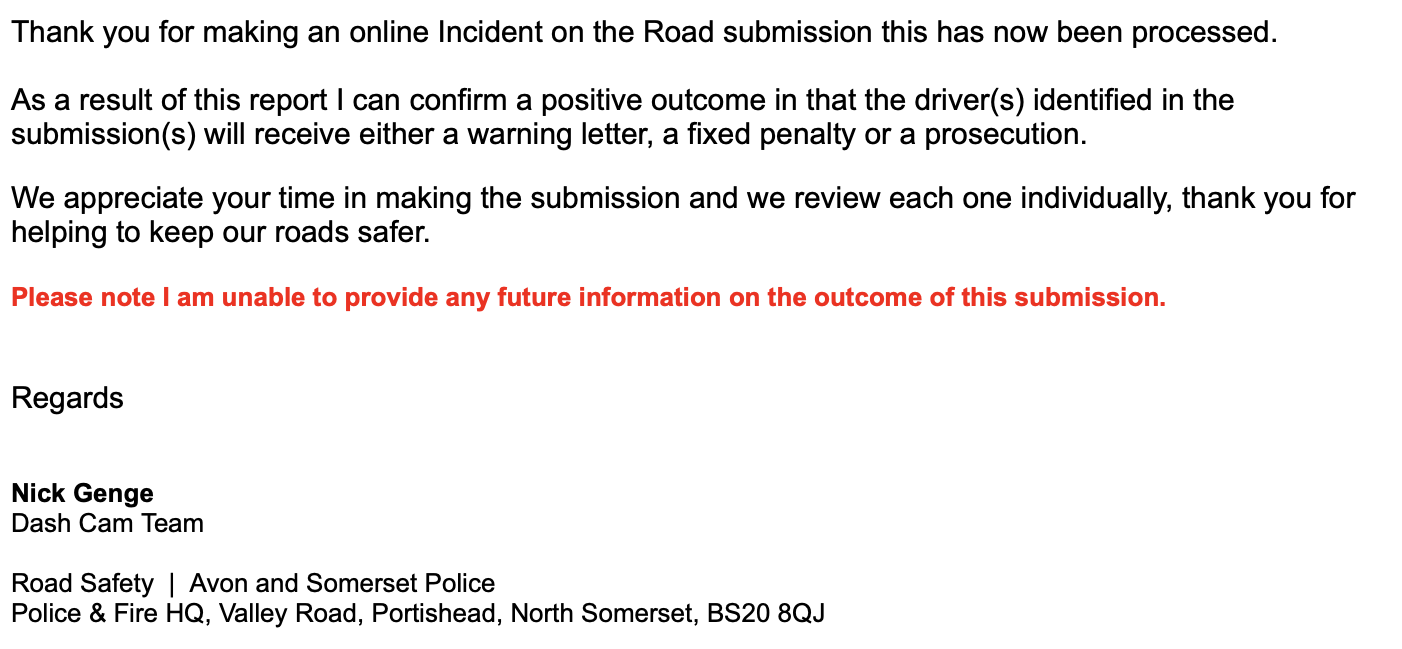
Results locally
Avon & Somerset Police are one of the more progressive forces. Bathonians are providing 100s of submissions every year (mainly by dashcam) and around 70% will result in some kind of action. As said above, the best result is a minor admonishment that wakes people up to their responsibilities when controlling large dangerous machinery.
One person in Bath reports around 85% acceptance rate!

Isn’t it a drop in the ocean?
Yes and no. The use of cameras is rocketing. As many as 20% of vehicles now have one and evidence in the event of insurance claim is a leading reason. With rising insurance premiums, people are only more likely in invest. A £200 dashcam to avoid being held responsible for a crash and protect a no claims bonus is a wise investment.
As far as cycling goes helmet cams are becoming a big thing simply to encourage drivers to keep a safe and legal distance away. When you have kids with you and such poor infrastructure it makes a lot of sense.
And even pedestrians are submitting camera footage of things like mobile phone use, zig-zag parking and dangerous obstruction of pavements.
But one thing people driving tend to overlook is the vast majority of submissions are by fellow drivers.
The whole point is to avoid ‘the big one’
My day job is in construction site management, and in that world there is a huge focus on reporting the ‘near misses’, where typically something happened but no one was seriously injured. The theory is tackling near misses stops ‘the big one’.
The aim of camera reporting is the same in my view. This is not about people getting points or fines or risking losing their licence. It is about stopping a far more serious incident caused largely by the same behaviours.
The ideal outcome for me is someone gets a letter from the police telling them off and they are furious to discover another road user has reported them. They post on social media about ‘grasses’. They tell their family, they tell their mates, they tell strangers at bus stops. Everyone nods and agrees “you are so hard done by…”. But they are thinking:
“I had better review my own approach to driving”
And hopefully the person who got the letter pauses for thought too. And little by little, we cut down on the big crashes that have such devastating consequences.
If you have experiences of reporting let us know in the comments!
